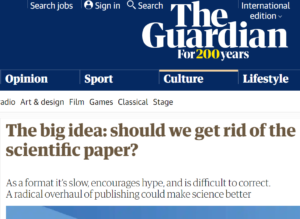By Adeilton Brandão, Editor in Chief of Memorias do Instituto Oswaldo Cruz, researcher at Instituto Oswaldo Cruz (Fiocruz)

Image: The Guardian.
We cannot think of the science practice without referring to scientific article. It is a crucial element in the modern practice of science. Since the foundation of the first scientific journal, Journal des sçavans in 1665, scientists from every branch of knowledge have conveyed their research results to the public through writing and publishing “scientific articles”. But the contemporary academic science, with its quantitative system of performance evaluation for individual scientists, has taken the scientific article to another level: rather than a means to disseminate research results, it is the “ultimate goal” to be attained by the individual scientist. Under this academic performance metrics the more articles (papers) a scientist publish the better, regardless of their scientific content.
In The big idea: should we get rid of the scientific paper?,1 published by the Guardian newspaper, Stuart Ritchie argues for a radical action: scientists should abandon the current format of the scientific paper, which is static and not interactive. Despite being currently published in electronic medium, they are still very similar to the printed version that dominated the scientific publishing landscape for more three centuries. In fact, the current scientific article is only an electronic version of “the physical black and white printed paper” in PDF (portable document format). This format is not friendly for reading on the screen of computers, tablets and mobile phones, which are dynamic and offer countless alternatives to interact with information. Reading a scientific article nowadays should be more than getting passive information about a subject matter, rather it should be an opportunity to think, check, review and reproduce the data and analysis presented in the article.
However, the standards of scientific publishing industry, and the rules of academic establishment as well, oppose any change in this static, passive and mostly non-transparent system of science dissemination. The Guardian newspaper article points out some alternatives to the PDF packaging of scientific articles, e.g., interactive “notebooks” that combine images, data, code, methods, and analysis into a single interactive and dynamic “article” that might be read, reviewed, reproduced, edited, and shared at any time. This format is known as “living article”.
But the problem does not lay solely on the “static scientific article”. There are the journals and the rules dictated (mostly) by the financial interests of the major commercial publishers. The predominant system for the communication of scientific results has not been developed by scientists, and they cannot freely decide what is the best “vehicle” or format to disseminate their research work. Actually, the publishers of scientific journals decide and control which format is accepted or not. A scientist today must follow the rules determined by journal editors, who are also dependent on the consensus and standards defined by the entire publishing industry.
By this reasoning, the problem is not the article itself, rather it is the vehicle that widespread the scientist’s message: the scientific journal and its rules! It is not possible to “get rid of the scientific article” without reforming the concept and practice of the “scientific journal”!
Note
1. RITCHIE, S. The big idea: should we get rid of the scientific paper? [online]. The Guardian. April 11, 2022 [viewed 14 April 2022]. Available from: https://www.theguardian.com/books/2022/apr/11/the-big-idea-should-we-get-rid-of-the-scientific-paper
Reference
RITCHIE, S. The big idea: should we get rid of the scientific paper? [online]. The Guardian. April 11, 2022 [viewed 14 April 2022]. Available from: https://www.theguardian.com/books/2022/apr/11/the-big-idea-should-we-get-rid-of-the-scientific-paper
About Adeilton Alves Brandão
Adeilton Brandão has a doctorate in Biological Sciences from Universidade Federal do Rio de Janeiro, and an executive education certificate from Sauder School of Business, British Columbia University – Vancouver. His research focuses on the untranslated segments of mRNA from protozoa parasites. He is a researcher at the Laboratory of Molecular Biology and Endemic Diseases, Instituto Oswaldo Cruz-Fiocruz, and Editor-in-Chief of Memórias do Instituto Oswaldo Cruz, a journal of microbes and their vectors causing human infections.
Como citar este post [ISO 690/2010]:

















I think Ritchie and Brandão are both wrong, ironically for the same reason. Turning articles into complex interactive media would take much more time than articles are worth, or that scientists have. Articles are basically long form announcements. People who then really need to understand what was done communicate with the researchers.
Moreover, articles are already quite dynamic. They have lots of links and in many journals there are lots of viewing options. They are nothing like static documents. In addition, advanced search technologies, including AI, provide many ways of seeing the article in various community contexts.
I suggest celebrating the great progress we are making, with much more to come.
Here is some additional thought, based on an email discussion of this blog article.
There are two issues here, both of which I have done research on.
Replacing the journal article
The present article has three primary components
Here is the problem
Here is what we did
Here is what we found
Proposed replacement raises four questions
What is proposed?
Why?
What is the cognitive cost?
How paid?
The cognitive cost is the extra effort required on the research’s part. How paid is what other cognitive activity is cut back? Research? Proposals? Teaching?
Ritchie’s proposed replacement looks very demanding. I see no consideration of the cognitive cost.
What are you proposing? You mention multiple narratives which sounds cognitively expensive. What are the supposed benefits of this extra work? What other activity should be cut back to pay for it?
The dynamics of the present system
It is not a few links. In the typical case there are thousands of immediately available links, in several different systems. The exploration potential is huge. I am looking at an article with about 40 references. Each is linked to Google Scholar, so for each reference article you can get all the articles that cite that article, plus the 100 semantically closest articles. So there are over 4,000 links to the immediate field, many more if there are a lot of citing articles. They also include Scopus and PMC links for many references, each with powerful exploration tools.
See https://www.thebreastonline.com/article/S0960-9776(21)00994-2/fulltext#relatedArticles
The topic is online patient educational materials, a major alternative to journal article access.
I did notice an opportunity, which is for the journal to add links to GS, etc., for the article itself when these become available.
Pingback: Un comentario sobre “La gran idea: ¿deberíamos deshacernos del artículo científico?” – Edición científica